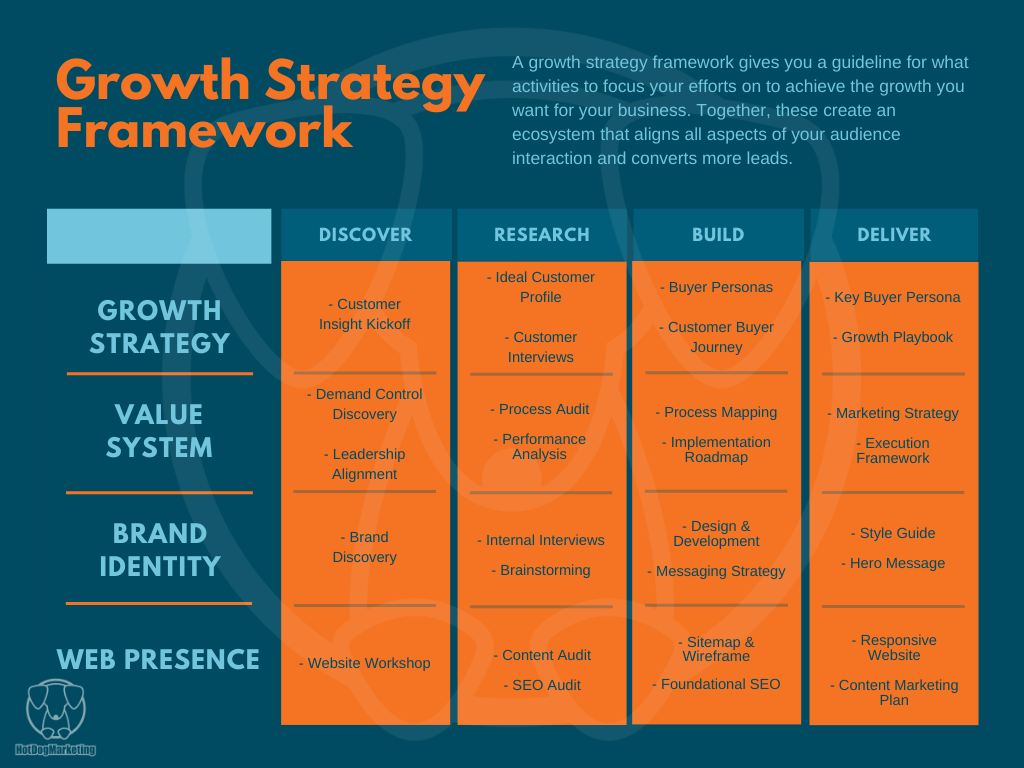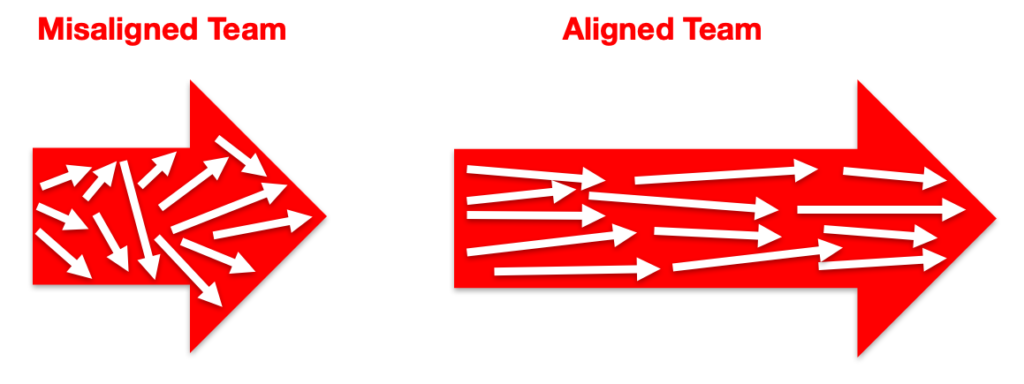A marketing strategy for predictable and sustainable business growth.

Imagine you are taking a road trip to Disney World. You buy your tickets online, pack the car, and hit the road. Map? GPS? Smartphone? Who needs them, right? You know Disney is in that general direction, and you’re headed that way – you’ll get there eventually.
Does this sound like a winning plan for an enjoyable family vacation or something more akin to the plot of a movie we might see starring Chevy Chase?
Okay, it might be fun for a little bit, but to get to your destination at some point, you’ll have to make a plan and utilize the appropriate tools to help you get there.
Growing your company is similar to our road trip visualization; and the car is your marketing. Without a plan and the right tools, you’ll be driving around but not getting to your destination, or at least, not at the pace you want.
Developing a marketing growth strategy can be challenging, but it is necessary for a successful business. It will ensure that your marketing efforts are not wasted, and you have a plan in place for growth. This article will provide an overview of the steps needed to create a growth strategy from scratch and how to align your marketing growth strategy with other facets of your business, such as value system, brand identity, or web presence.
How do you develop a marketing growth strategy?
The first step to developing a marketing growth strategy is to understand your customers. Who are they? What do they want? Why should they buy from you instead of someone else in the marketplace? How will you get them excited about your brand, product, or service? If you can answer these questions, it’s easier to know where and how to spend your marketing dollars.
At Hot Dog Marketing, we utilize the growth strategy framework. This framework enables us to map out all the pieces of a marketing growth strategy systematically and in the areas that are most effective for the business and audience. It consists of four aspects and four phases. The discover, research, build, and deliver phases do not need to happen simultaneously for each framework channel.
Each channel is unique and essential to the success of the plan. I’ll go over each of these channels and what they mean for your overall marketing plan.

1. Growth Strategy
The growth strategy element of the framework is where you learn who your customer is and how they’ve interacted with your brand. The results might surprise you. In many cases, business leaders think their customers look one way, only to find out their customers are entirely different. Or they believe they know what their customers want or why they buy but are woefully incorrect.
For example, Ron Johnson, CEO of JCPenney in the mid-2010s, decided to model their stores after the ever-popular, modern Apple stores and do away with coupon sales, offering everyday low prices instead. After all, fair and transparent pricing is much better than time-consuming bargain hunting and coupon clipping, right?
Well, their customers didn’t think so. The “
Well, their customers didn’t think so. The “everyday low prices” plan was a disaster. Customers complained, boycotted, and even turned to JCPenney’s competitors to satisfy their craving for a great bargain – even if it was an item for the same price JCPenney offered. What Johnson didn’t understand about his customers was that they didn’t simply want low prices; they wanted to find a treasure. That treasure was a good deal and the feeling that comes with thinking how much money they saved by purchasing items with markdowns or coupons.

Although this was a single contributing factor to JCPenney’s fall from retail prominence, it certainly was a big one.
Solution: Customer Interviews, map out the Customer Journey, build a Buyer Persona with demographics and psychographics.
Deliverables associated with this channel: Growth Playbook, Key Buyer Personas
2. Value System
A company’s value system can be implicit or explicit, depending on how leadership has built the culture. The issue with implicit values is that employees and others on the leadership team may not know exactly what the company values are or have different interpretations of them. For instance, one implied value may be to do what is “in the best interest of the company.” However, the Chief Financial Officer may interpret that to mean they should always act in a way that positively affects profit margins. On the other hand, a team manager might understand that what is best for the company is a satisfied workforce with a high morale that leads to better customer service and production efficiency.
Neither are wrong. They both believe they are acting in the company’s best interest. However, the company leadership has not clearly defined what “best interest” means. While this often doesn’t create two opposing forces that have management at loggerheads, it can slow the overall progress of its growth. In my example, I’m referring to internal company values, but the same applies to external values, such as target audience, customer value proposition, product category, sustainability, etc.

Marketing communicates the value a company’s product or service delivers to its customers. If leadership is misaligned in these values, it inherently slows progress. I like the graphic above, but let’s flesh it out a bit more. Imagine your company is like a boat; the leadership are oarsmen, rowing in what they think true North. However, the boat captain (your company’s top brass) is the only one with the compass that can point everyone toward true North. If they fail to do so or are vague about it – you know, North is like, that general direction – then the boat will move, but much slower than possible.
On the well-functioning side, imagine this scenario:
- An Olympic rowing crew slicing through the water
- Rowing in perfect unison
- Lead by the perfectly timed cues of the cockswain
When I was younger, I never understood the role of the cockswain in a rowing crew. I figured if everyone knew where they were going and what to do, they should be able to manage it themselves, right? Wrong, wrong, wrong. That leader with the megaphone is crucial to the success of the team. Okay, I think I’ve stretched this analogy as far as it can go.

Solution: Process Audit, Performance Analysis, and Stakeholder Discovery Meeting
Deliverables associated with this channel: Marketing Strategy, Execution Framework
3. Brand Identity
We have talked in depth about a brand identity before, but I’ll provide an overview here. Contrary to popular belief, a brand is not simply the logo a company stamps on its products; it is a shared, holistic experience. It includes the product itself and everything from how it’s promoted to what colors are associated with it.
At this point, we’re all familiar with Apple’s brand identity: the sleek colors, intuitive tech hardware, and minimal but beautiful packaging design. It’s highly visual and has a lot to do with the customer experience when unboxing and interacting with their products.
Also, consider Patagonia’s brand identity. Patagonia makes outdoor apparel and gear. You may not be able to identify their product from the competition from far away, but their brand is more than the logo sewn onto their jackets. For Patagonia, they charge higher prices so they can make high-quality products that you’ll never have to replace. They’re committed to climate justice and sustainability – and vocal about it! They’ll repair any Patagonia product for free (no receipt necessary!), and they even discourage people from buying new products if they own something similar already. The point is that Patagonia’s brand is not nearly as visual or even experiential as Apple, but it is built on the values of its customers. On Patagonia’s homepage, they even have a tab for “Activism.”
A brand identity should communicate what your company stands for, and if you can align that with who your customers want to be or think they already are, you’ll have a winner on your hands.

Solution: Brand Discovery, Internal Interviews
Deliverables associated with this channel: Messaging Strategy, Visual Branding Style Guide
4. Web Presence

Don’t think a website matters? Think your work speaks for itself? Think a Facebook page is good enough? Get all your customers from word of mouth?
smh.
The truth is that your target audience is online, and they’re likely searching for the solution you offer. If they heard about your company via word of mouth, they’ll go online to learn more. If your “work speaks for itself,” they’ll go online to view product pictures and other customer reviews. If you only have a Facebook page, they might not want to sift through posts and pics to find the info they want.
Your website should be home base. Similar to if you have a physical store. Of course, you may carry products with other retailers, but your store is where you can control every aspect of the customer experience. You can’t replicate this experience on Instagram or other social media platforms. Your website allows you to showcase your products, explain how they’re made and why people love them — all in one centralized location that’s easy for customers to find.

Here are a few more reasons why it’s essential: Consumers want information quickly, such as product details or service areas; customers want to understand if a product can solve their problem; and they want to see how the product compares to competitors. Social media is helpful for building a web presence, but it doesn’t intuitively allow users to navigate their way through the platform to find the information they want. A professional-looking website communicates professionalism, trust, and modernity to your audience. You can’t expect your customers to discover all those things on social media. Your company’s website should be the hub that holds everything together and integrates with other platforms, such as Facebook or Instagram. Use social media and other platforms not as an end in themselves but to drive traffic back to your website.
Solution: Website Workshop, Content Audit, SEO Audit
Deliverables associated with this channel: A Responsive Website, Content Marketing Plan
Conclusion
Just like taking a road trip, you need a plan to get to where you want to go. If you have a destination in mind, don’t simply jump into the car and take off – create a strategy that will lead you to predictable, sustainable progress. A Growth Strategy Framework is a guide you need to develop an ecosystem to market to your target audience and progress towards your business goals. Meet them where they are, when they’re ready, and give them what they want.
Are you ready to take the leap and go for it?

Tom Snyder is a business-minded writer creating compelling content that helps business owners understand the digital side of their business and engage with their audience. Constantly intrigued by learning new things, he is fascinated with tech, business, and sci-fi. In his spare time, you can find Tom building his own business (coffee roasting) or making music.